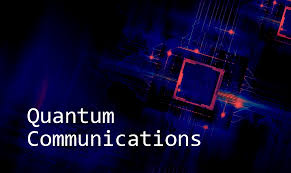By sending quantum information several kilometers,
the researchers took a big step toward the future of information security
11 November 2017 – In the hurly-burly of this past week’s national and international politics plus the unending stream of high-profile sexual misadventures, it was easy to miss some really big technology stories. Ok, perhaps a bit prosaic compared to that other stuff but still important.
Patrick Tucker at Defense One sent out a blurb earlier this week about a team of Chinese researchers who say they have completed the first long-distance quantum secure direct communication, a critical step toward sending messages that are truly safe from eavesdropping. The information traveled 2.7 kilometers along a quantum channel according to the team paper that was peer-reviewed by China’s Science Bulletin journal and placed online Oct. 22 (you can read the English version of the full paper via arxiv.org by clicking here).
As I noted in a longer piece earlier this year from the International Cybersecurity Forum in Lille, France, quantum secure direct communication (commonly known in the science as “QSDC”) is an important quantum communication branch, which realizes the secure information transmission directly without encryption and decryption processes. So this development by the Chinese is astounding. Why? The feat, if verified, marks a critical step forward in the pursuit of communication that does not require end-to-end encryption and cannot be secretly intercepted by a third party. Today’s best encryption standards are nearly impossible to crack, but “nearly secure” is not “secure.” With enough computing power, they can be broken, just as Alan Turing’s Automatic Computing Engine penetrated Nazi Germany’s Enigma ciphers. But quantum secure direct communication doesn’t rely on codes that can be cracked, but rather on something far more secure: the laws of physics.
So just a wee bit of science to get you through the basics:
- In classical computing, logic gates in integrated circuits convey pieces of information are called bits. These are detectable and interceptable by nature, hence the need for ciphers and encryption.
- In quantum-scale communication — meaning on atomic sizes — information is conveyed by particles, rather than logic gates embedded in integrated circuitry. These particles, such as vertically or horizontally polarized photons, carry this information in their state of spin and other characteristics. Science has named those units of information: qubits. Two qubits sharing the same quantum state form a channel.
So why is quantum communicating more secure than the classical methods? Subatomic particles behave differently than larger objects. As physicist Werner Heisenberg observed, merely attempting to keep tabs on subatomic particles using giant, crude, human-sized instruments changes their behavior. You can never be certain what you’re viewing. This is Heisenberg’s famous uncertainty principle.
If you can send information through a secure quantum channel, no one can intercept that communication without changing it in a way that both sender and receiver will detect. No fancy encryption is necessary. However, quantum communication in a way that’s comparable to traditional electronic communication will also requires quantum memory to store photonic quantum information. Quantum memory was discovered in 2010, but is very difficult to create at usable scale.
It’s an area of vital national security importance. Magazine’s like Tucker’s Defense One and Jane’s Defence Weekly – – well, scores of defence magazines — have had a stream of articles on how perfect information security gives a clear advantage over an adversary that lacks it. Quantum communication might even persuade an adversary to give up attempts to intercept secure messages, since such eavesdropping would be easily detected.
And as I noted in my wrap-up a few weeks ago on the follow-on Munich Security Conference, both China and the United States have big investments in quantum communication. But while U.S. investment was robust a few years ago, China has since demonstrated surprising expertise and ambition and has pulled way ahead — in terms of investment, in terms of new papers published in the field, and in terms of big public projects such as a quantum communication satellite and long-range cable.
Chinese scientists have demonstrated actual quantum secure direct communication — with quantum memory — in several tabletop experiments. So this most recent breakthrough is another large step toward secure quantum communication at meaningful distances. The researchers (the paper is a tough read but skip the math and just scan it) say that the method could be scaled up to send messages “tens of kilometers.” The U.S. has not achieved anything close to these milestones.
Yet another example of China vaulting ahead in an area where the U.S. was comfortably dominant not long ago. Chief among the reasons for this growing trend is that U.S. funding for basic science is unpredictable at best. Conversely, Chinese investment is strategic, sustained, and stable – particularly in quantum science. Put simply, the U.S. does not appear to be prioritizing investments in quantum sciences at comparable levels to China.
It is same pattern we are seeing in artificial intelligence where many experts think the U.S. will lose its edge to China in AI development. The leading AI researchers, university departments and research labs are still in the U.S. but China is moving fast and has the financial firepower that the U.S. does not have. Not only do Chinese companies have the advantage of a hyper-competitive market in which the leading players typically compete across a range of applications and use cases (compared with more specialized leaders in the U.S. so AI research and development is diffuse), the Chinese government continues to invest billions in R&D while unstable U.S. visa policies … and big checkbooks in China … have encouraged more academics to return to China after attending universities in the U.S. More importantly, China has a very, very deep awareness of what’s happening in the English-speaking world, but the opposite is not true. The West has very little feedback on what’s happening in China, hence our amazement when they show off incredible stuff in robotics, neural networks … and now even quantum computing.

